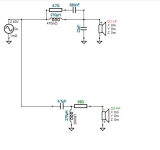Maybe a two-way premade crossover (at 3500Hz) from Dayton Audio would be a good choice for now 🤔
If it is designed for the specific drivers you will be using, that may be the way to go. If not, the crossover transition may be a little messy.Maybe a two-way premade crossover (at 3500Hz) from Dayton Audio would be a good choice for now 🤔
You probably should model it in VituixCad to be sure. In your model, be sure to use not only the on-axis frequency response data, but also the off-axis data. Dayton provides frequency response data for 0, 15, 30 and 45 degrees. I downloaded Dayton's frequency response data for the RS100-4 and it looks to be in pretty good shape for a 3500Hz crossover frequency.
Yes, I imported all the frd-files from both drivers 🙂
The tweeters have an Fs around 1600Hz, so i guess 3500Hz crossover is a good startingpoint at least.
The tweeters have an Fs around 1600Hz, so i guess 3500Hz crossover is a good startingpoint at least.
Optimizing for car audio is challenging. Keep in mind where you are going to install the drivers, and the angle your ears are going to be with respect to the axes of the drivers. If possible, it is best to mount them high with the tweeter as close as practical to the woofer.
EDIT: I just looked at the picture of another car like your that you posted. Those locations may be your best bet.
EDIT: I just looked at the picture of another car like your that you posted. Those locations may be your best bet.
HI, Looks like a fun project you're playing with.
I knocked up a starting point for an Xover network for you.. nothing exciting, but yields pretty good behaviour, sane xover points and pretty flat response (within the context of the chosen drivers).
Let us know how you get on with this.. looking forward to seeing your progress.

I knocked up a starting point for an Xover network for you.. nothing exciting, but yields pretty good behaviour, sane xover points and pretty flat response (within the context of the chosen drivers).
Let us know how you get on with this.. looking forward to seeing your progress.
Attachments
Lots of people with a variety of experiences is what makes a mechanism like this so useful.. and quite entertaining
So, finally got the chance to take som measurement (right side). It seems that I can make a crossover at a lower frequenzy than roughly 3600 as in the model in earlier posts, maybe at around 2500Hz? And how do I import the measurements (frd) to Xsim? I tried to rename the file to .frd, but I got an error in Xsim.

So, how have you taken those measurements? ie: from the listening position? from a specific distance from each driver? Identical power applied to each driver for measurements? --forgive if obvious questions, just trying to get a baseline..
Also, your measurements, to export as .frd, you use --file, export, export measurement as text.. next screen will allow you to set the .frd suffix..
Also, your measurements, to export as .frd, you use --file, export, export measurement as text.. next screen will allow you to set the .frd suffix..
I took the measurements sitting in the driver seat (left seat in Norway) and rotated the microphone 3-4 times around each ear while playing a pink noise 🙂
Oh.. and the drivers where placed in factory locations beeing played and measured seperatly.
Oh.. and the drivers where placed in factory locations beeing played and measured seperatly.
Ok, great stuff.. A simple notch filter might serve well to tame that huge peak centred around 200Hz.. beyond that, based on having tinkered with one of those HF units, I'd think about crossing over perhaps 2750ish.. I know the LF will go higher, but the 3-5kHz range will be more elegantly handled by that HF unit than the LF. You should end up with a pretty respectable sound out of it in the end. Great project.
Thanks for the input 😊
I know I can't do much with the massive dips, but I will try to get a more "flat" response from 250Hz and up, below that a good gradual increase in the curve.
I listen to a lot of metal and maybe have to adjust it a bit down in the 3000-8000 range. Any experience there?
Note; It is in a BMW F20 with a Matchup 7bmw DSP amplifier. Just want to try cutting the high frequencies away from the door mounted midrange and letting the tweeters play in that range.
I know I can't do much with the massive dips, but I will try to get a more "flat" response from 250Hz and up, below that a good gradual increase in the curve.
I listen to a lot of metal and maybe have to adjust it a bit down in the 3000-8000 range. Any experience there?
Note; It is in a BMW F20 with a Matchup 7bmw DSP amplifier. Just want to try cutting the high frequencies away from the door mounted midrange and letting the tweeters play in that range.
- Home
- Design & Build
- Electronic Design
- Help with crossoverdesign
